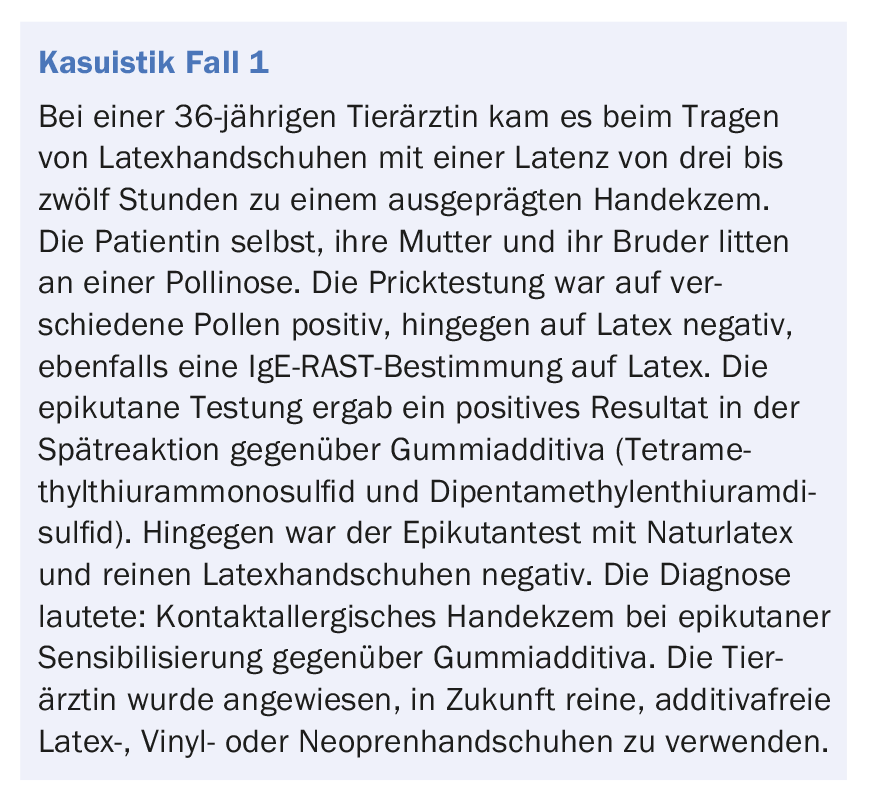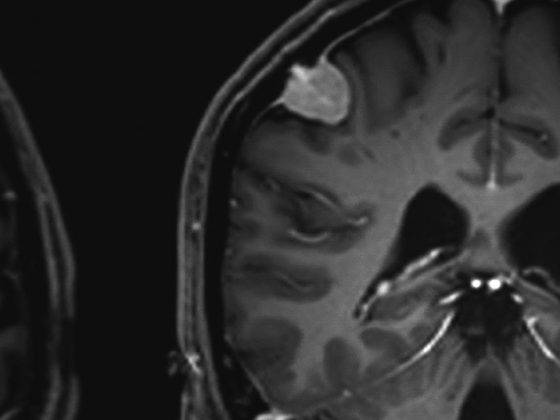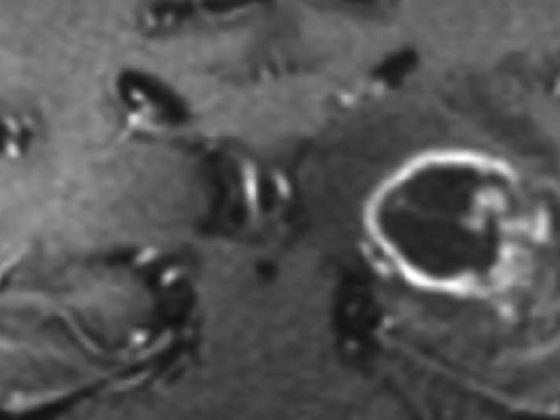At the New Year’s dinner, the chief surgical resident ended up in his emergency ward with an acute allergy attack already at the aperitif. Latex allergens were responsible for this.
At the New Year’s dinner, the surgical chief physician landed in his emergency ward of a hospital in eastern Switzerland with an acute allergy attack already during the aperitif.
Medical history
The 43-year-old surgeon came to see me just before Christmas because he had recently been suffering repeatedly from sneezing attacks, nausea and malaise after a meal. The last episode was particularly severe: sneezing, coughing, dyspnea, facial flushing, and urticaria all over the trunk with orthostatic collapse tendency occurred after a light night meal. There was rapid improvement after treatment in the emergency department with intravenous administration of an antihistamine and a corticosteroid preparation.
Allergological anamnesis and clarification
The colleague suffered from rhinitis with asthma in childhood until the age of ten, and as an adult he suffered only mildly from hay fever in summer. Twenty years ago, he had a “rubber glove allergy,” which is why he only uses plastic gloves.
Routine prick tests for inhalant allergens were strongly positive for grasses and rye pollen, and negative for all others. Food testing in the overview including spice series was positive only for peppers +. The prick test for latex was ++ positive. The patient himself suspected a cheese allergy, therefore, after negative prick tests for milk and casein, intradermal tests were performed, which showed an immediate + slightly positive (non-specific) reaction only to cheese (Gruyère).
Extensive IgE determinations were already performed away from home (!): Total IgE was 229 kU/l, Sx1 (inhalation mix) and grasses (early and late bloomers) were class 3 positive, specific IgE to trees I and trees II, Swiss herbs, animal epithelial mix, mold mix, house dust mite mix, Dermatophagoides pteronyssinus, food mix, nut mix, seafood mix, cereal mix and mold cheese were all negative.
Based on the patient’s assumption of a cheese allergy and the positive prick test for latex, I specifically ordered further serological tests and informed the colleague in writing at the end of December – unfortunately, the following did not reach him until the third day of the month. January: “The IgE test (CAP test) for milk and casein was negative, but for latex class 3 clearly positive. As cross-allergies with ficus as well as bananas and avocado are known, I have arranged for further tests and will inform them of the results on the occasion of the agreed control at the beginning of January.”
Course
At the New Year’s dinner, the hors d’oeuvre was an avocado cocktail; promptly, massive Quincke’s edema with severe dyspnea occurred, landing the surgeon in his emergency department. CAP results received by me on January 5 showed an IgE level of 9.1 kU/l (class 3) on latex, 1.3 kU/l (class 2) on avocado, and 0.68 kU/l (class 1, questionably positive) on banana, negative on kiwi and ficus. Thus, the following diagnosis could be made: Acute Quincke’s edema to avocado and sensitization to banana as a cross-reaction with latex in the sense of a “latex-fruit syndrome”. Status post contact urticaria to latex acquired from wearing latex gloves.

The surgeon was not aware that his “rubber glove allergy”, which he had suffered from twenty years ago and which had not been clarified, was due to a latex allergy. Thus, since diagnosis, he paid attention to cross-reactivity with other foods in “latex-fruit syndrome” (Figs. 1 and 2) and to the absence of Ficus benjamina plants[1] in his vicinity.


Comment
Allergy to rubber gloves may be due to immediate-type, IgE-mediated latex allergy, late-type contact allergy to so-called vulcanization accelerators, e.g. thiurams, tithiocarbamates, mercapto mix used in rubber manufacturing (case no. 1 in the box “Casuistry”), and very rarely (like case no. 2 in the box “Casuistry”) could be attributed to a late-type contact allergy to latex [2]. The clinical picture of an immediate-type allergy to latex corresponds to contact urticaria, which in the sense of a contact urticaria syndrome [3] can also occur as generalized urticaria, asthma, or even as anaphylaxis (contact urticaria syndrome grade 4, see Tab. 1) (case no. 3 in the box “Casuistics”).

Latex allergy: an increasing problem in the healthcare sector
In the eighties and nineties of the previous century, latex, the rubber raw material, gained more and more attention as an allergen [4,5]. The widespread use of latex gloves and of latex products in medical articles and in articles of daily use meant that more and more people were exposed to natural latex and thus became sensitized. The central importance of protecting against infection with rubber gloves and condoms in HIV prophylaxis had contributed to this. Another important factor for the increase in latex allergy was the fact that to improve gliding properties when putting on gloves, volatile cornstarch powders were used instead of inert, non-absorbable talc particles, since talc particles fell down when gloves were removed intraoperatively, in the surgical area, e.g., into the abdominal cavity or, in the case of orthopedic surgery, into the muscles, remained in the tissue and thus caused talc granulomas. Particularly in the case of insufficient or accelerated vulcanization of the natural latex, which massively reduces the cost of production, latex proteins are released from the gloves and bound to the corn starch. This leads to the dispersion of volatile cornstarch particles with latex allergens bound to them in the room air when the gloves are put on and taken off.

To reduce costs, less expensive latex gloves with a high release of latex proteins were purchased by the hospital administration. As a result, significant levels of latex allergens have been measured in indoor air in some operating rooms, nursing departments (dressing changes, etc.) and laboratories. This resulted in increased contact urticaria symptoms not only from skin contact with latex, but aerogenic sensitization and immediate-type allergic respiratory manifestations (rhinits, asthma) occurred when latex proteins were inhaled in room air (case no. 4 of the case report). The incidence of latex sensitization in healthcare workers at times exceeded 15% latex allergies. This prompted hospital administrations worldwide to ban the use of powdered latex protective gloves (see, e.g., USZ: www.mul.uzh.ch/sortiment/eshop/MerkblattLatex-Allergie.pdf).
Several intervention studies demonstrated that replacement of powdered latex gloves with low-protein powder-free latex gloves or latex-free gloves was an effective preventive measure. It led to a substantial reduction in latex allergens in the air at the workplace, a reduction in the rate of sensitization, and a decrease in cases of illness with bronchial asthma in healthcare workers [6].
Latex sensitization via the bloodstream or mucous membranes
Sensitization to latex allergens via the bloodstream or mucous membranes also occurs, particularly in patients exposed to multiple surgeries early in life. Primary among these are children with spina bifida and/or urogenital malformations (www.pflegewiki.de/wiki/Latex-Allergie_bei_Spina-bifida-Patienten). Due to surgical procedures, early and intensive mucosal contact with natural rubber gloves and other latex-containing materials occurs repeatedly. As a result, sensitization usually occurs in the first days of life. This is then amplified by the follow-up measures and manipulations (e.g. repeated manual clearing out in rectal atresia) of the patients using latex gloves, latex underlays, etc. There is a correlation between the number of surgeries and the degree of latex sensitization using the example of spina bifida patients. More than five surgeries significantly increase the risk of latex hypersensitivity. A number of ten or more operations poses a significant risk of anaphylactic reactions. In addition, the genetic predisposition of the individual appears to play a role, as indicated by the fact that atopics are at increased risk of developing latex hypersensitivity.

Extraction and processing of natural rubber
Latex is obtained from the milky sap of the rubber tree (Hevea brasiliensis) from the Euphorbiaceae family, which originally comes from Brazil. Today, however, most of the world’s rubber demand is met by petrochemically produced synthetic rubber. The liquid, known as latex or milky sap, is released by scoring the bark of the tree and collected in containers. Latex milk is an emulsion of 30-35% rubber droplets from 0.0005 to 0.001 mm in diameter, 5% proteins, sterols, fats and carbohydrates, 0.5% minerals and 60-65% water. The latex milk is coagulated on the spot so that the raw rubber separates from water as a solid mass (coagulation). But it was the classic vulcanization technique involving the reaction of natural rubber with sulfur, developed by Goodyear in 1839, that turned rubber into a valuable technical product. In this process, the polyisoprene chains are cross-linked by sulfur bridges so that the molecules can no longer move freely against each other, resulting in elastic behavior. Depending on the sulfur content, the product becomes soft or hard rubber. The vulcanization technique was decisively improved by adding accelerators (thiurams, carbamates, thiazoles) and activators (zinc oxide, antimony sulfide) [5].
Latex Allergenic
Water-soluble proteins with a molecular weight between 10,000 and 67,000 daltons and trypsin sensitivity were identified as the responsible allergens in latex [7]. In the following years, several latex allergens (major and minor) could be characterized molecularly and biologically [8,9]. The diagnosis of “true” latex allergy in the presence of detected IgE antibodies (CAP, Phadia) to total extract from Hevea brasiliensis latex (k82) enriched with Hev b 5) can be made by using recombinant allergens against the following latex components (r = recombinant allergens):
- rHev b 1 (k215), Rubber elongation factor, major allergen; especially in patients with spina bifida; cross-reactivity not observed so far.
- rHev b 3 (k217), small rubber particle protein, major allergen; especially in patients with spina bifida; cross-reactivity not observed so far.
- rHev b 5 ( k218) Major allergen; acidic protein, in patients with spina bifida, medical personnel, and latex allergic patients; high concentration in powdered gloves; cross-reactivity not observed to date.
- rHev b 6.01 (k219), prohevein, major allergen, chitin-binding protein; specific allergen component, in addition to spina bifida, especially in medical personnel and latex allergic individuals; cross-reactivity with plant foods, especially avocado, banana, kiwi.
- rHev b 6.02 (k220), hevein, major allergen; in addition to spina bifida, especially in medical personnel and latex allergic individuals; cross-reactivity with plant foods, especially avocado, banana, kiwi.
- rHev b8 (k221) profilin, minor allergen; low clinical relevance; panallergen, with marked homology and cross-reactivity even among distantly related plant species; found in pollen, latex, and plant foods.
- rHev b 9 (k222), enolase, minor allergen; cross-reactivity with molds possible.
- rHev b 11 (k224), class 1 chitinase, minor allergen; cross-reactivity with fruits possible.
Conclusions
Although the use of powdered latex gloves has decreased and so have the cases of latex allergy of the immediate type, there are still such latex gloves with corn powder on the market, and the risk for a latex allergic person still exists when coming into contact with latex gloves during gynecological examinations, dental procedures, surgery, or when coming into contact with latex condoms. If latex allergy is suspected, the specific IgE (CAP) to latex (r82) should be determined in the practice and, in specific situations (latex-fruit syndrome, spina bifida children, polyoperated patients), the main allergens should be determined according to the above information and the patients should be oriented accordingly with regard to prophylactic measures (use of latex-free objects, emergency card to present to dentists, surgeons and nursing staff, use of latex-free condoms, possibilities of cross-reactions in latex-fruit syndrome, etc.).) should be oriented in detail. If the latex allergy appears during the apprenticeship or the occupation when coming into contact with latex-containing material, the case must be registered with SUVA as an occupational disease.
Literature:
- Wüthrich B, Anliker M, Bircher A: Indoor allergens: Ficus benjamina and other green housemates. HAUSARZT PRAXIS 2017; 12(4): 14-19.
- Wyss M, Elsner P, Wüthrich B, Burg G: Allergic contact dermatitis from natural latex without contact urticaria. Contact Dermatitis 1993; 28: 154-156.
- Maibach HI, Johnson HL: Contact urticaria syndrome. Arch Dermatol 1975; 111: 726-730.
- Fabro L, Mühlethaler K, Wüthrich B: Anaphylactic reaction to latex, an immediate-type allergen of increasing importance. Dermatologist 1989; 40: 208-211.
- Wyss M, Wüthrich B, et al: Latex allergy – an increasing problem in practice. Schweiz Med Wochenschr 1993; 123: 113-119.
- Tarlo SM, Sussman G, et al: Control of airborne latex by use of powder-free latex gloves. J Allergy Clin Immunol. 1994 Jun; 93(6): 985-989.
- Jäger D, Kleinhans D, et al: Latex-specific proteins causing immediate-type cutaneous, nasal, bronchial and systemic allergic reactions. J Allergy Clin. Immunol. 1992; 89: 759-768.
- Cullinan P, Brown R, et al. : Latex allergy. A position paper of the British Society of Allergy and Clinical Immunology. Clin Exp Allergy 2003; 33: 1484-1499.
- Raulf M, Rihas HJP : Latex allergens: sources of sensitization and latex allergens. In: Kleine-Tebbe J, Jakob T (eds). Molecular Allergy – Diagnostics, Springer, Berlin – Heidelberg, 1st ed. 2015: 322-349.
DERMATOLOGIE PRAXIS 2017; 27(6): 37-41
DERMATOLOGIE PRAXIS 2018 Special Edition (Anniversary Issue), Prof. Brunello Wüthrich













